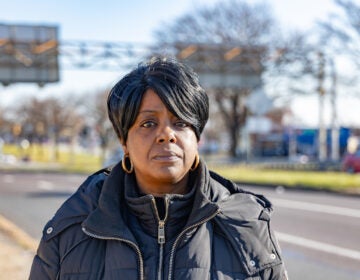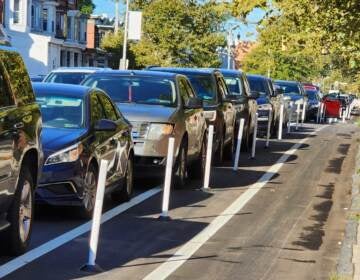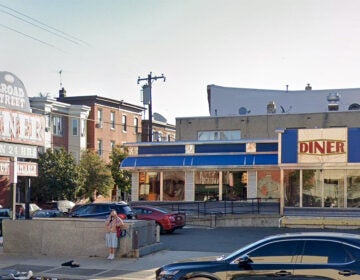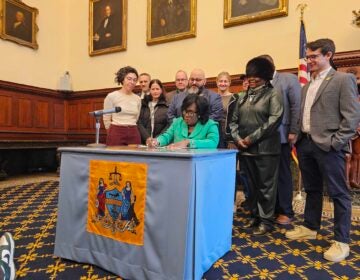‘No-brainer’ on Broad: PPA preparing to install automated speed cameras along Philly’s most dangerous roadway
Advocates hope the cameras will reduce traffic fatalities and serious injuries along the busy corridor.
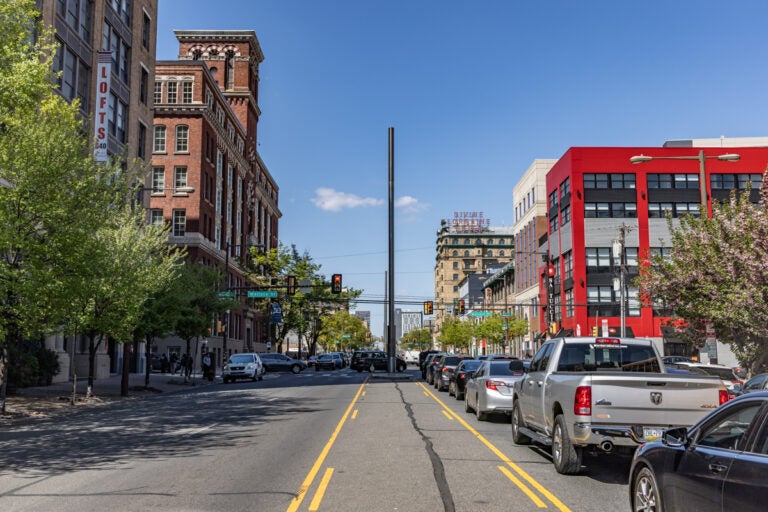
North Broad and Wallace streets in Philadelphia. (Kimberly Paynter/WHYY)
Have a question about Philly’s neighborhoods or the systems that shape them? PlanPhilly reporters want to hear from you! Ask us a question or send us a story idea you think we should cover.
The Philadelphia Parking Authority hopes to start installing automated speed cameras on Broad Street in the coming months.
Executive director Rich Lazer said the goal is to get them up in early 2025 and that the work should only take a matter of weeks to complete.
The cameras will be installed along the entire length of Broad Street — between Old York Road near East Oak Lane and the Navy Yard in South Philadelphia. They will appear about every mile of the roughly 10-mile stretch.
“The goal is to have people follow the speed limits — to have crashes and injuries drop,” said Lazer, whose agency will also manage the devices.
The cameras will be the first visible piece of a newly expanded program under Vision Zero, a citywide initiative launched by Mayor Jim Kenney’s administration to eliminate all traffic-related deaths and severe injuries in Philadelphia.
Legislation signed into law late last year authorized the addition of speed cameras to five more corridors and up to five designated school zones. The measure also made permanent a pilot program launched on Roosevelt Boulevard, widely considered one of the city’s most dangerous roadways.
Why Broad Street?
In June, Philadelphia City Council approved the cameras for Broad Street following a monthslong process to identify potential corridors for the expansion. Of the five most dangerous corridors, Broad Street topped the list, making it the obvious starting point for the program’s expansion.
“In particular, sections of North Broad just have an unconscionable level of traffic violence right now. So it was a no-brainer from the data,” said Christopher Puchalsky, director of policy and strategic initiatives with the city’s Office of Transportation and Infrastructure Systems.
As of Tuesday, seven people have been killed in crashes on Broad Street this year, according to city-held data. That’s double the number of traffic fatalities on Roosevelt Boulevard during the same time period.
The total includes the two men killed in late June in a head-on collision at the intersection of Broad Street and Hunting Park Avenue. A third man was killed a few days later after a driver struck him near Broad Street and Fairmount Avenue.
Between 2018 and 2022, there were 169 serious or fatal crashes on Broad Street and 165 speed-related crashes, according to PennDOT. There were 456 pedestrian-involved crashes.
“Once we look at crashes related to speed compared to other roads in the city, Broad Street is just so much higher,” said Nicole Brunet, policy director for the Bicycle Coalition of Greater Philadelphia.
The new cameras are part of a broader effort to address what advocates consider a traffic safety crisis, one that has coincided with a dramatic decline in the number of traffic tickets issued by city police.
Through the first six months of 2024, at least 51 people have died in Philadelphia traffic crashes, according to city-held data. Nearly half of them were pedestrians. That puts the city on pace to again surpass the totals recorded in 2019 — the year before traffic fatalities surged in Philadelphia and nationwide.
Next steps
While opponents maintain the cameras arbitrarily increase the cost of driving, backers argue they are among the more effective ways of deterring drivers from speeding.
On Roosevelt Boulevard, the cameras reduced speeding by 95% at the 10 intersections where they were installed, according to a recent city report.
“It’s not that the fine is particularly large. It’s not that there’s huge consequences. It’s that I know if I do this I will get a fine. And that gets people to correct their behavior. And then once you get enough people acting safe and rationally, that impacts the traffic flow for the entire corridor,” said Puchalsky.
The goal is to get to a point where there are hardly any speeding violations.
“We would love to have no violations,” said Lazer. “It’s more about safety than anything else.”
Once the cameras are installed, there will be a 60-day grace period during which drivers will be issued a written warning instead of a violation, said Puchalsky. After that, drivers must be traveling at least 11 miles per hour over the posted speed limit to receive a violation, which can run up to $150 in corridors and school zones.
The PPA will collect revenue from the violations and send to PennDOT to put toward a dedicated fund that issues grants to municipalities for traffic safety projects. To date, Philadelphia has received nearly $30 million from that fund, according to the PPA.
Over the summer, the city will set the speed limit on Broad Street at 25 mph. Currently, the speed limit is 25 mph on South Broad Street and 30 mph on North Broad Street. That work will be completed before the cameras are activated.
The city is working on determining the speed limits for the other four corridors set to receive speed cameras:
- State Route 13 (Baltimore Avenue/Roosevelt Boulevard/Frankford Avenue)
- State Road 2016 (Allegheny Avenue)
- State Road 3 (Chestnut Street/Walnut Street)
- State Road 291 (Penrose Avenue/Bartram Avenue/Moyamensing Avenue)
It’s unclear when legislation for those cameras will be introduced in City Council.
The first council session after the summer recess is Sept. 5. Puchalsky said those bills can be introduced once the city completes engineering studies for each of the remaining corridors, a task that could be completed by the fall.
The cameras may be installed on different corridors simultaneously.

Subscribe to PlanPhilly
WHYY is your source for fact-based, in-depth journalism and information. As a nonprofit organization, we rely on financial support from readers like you. Please give today.




